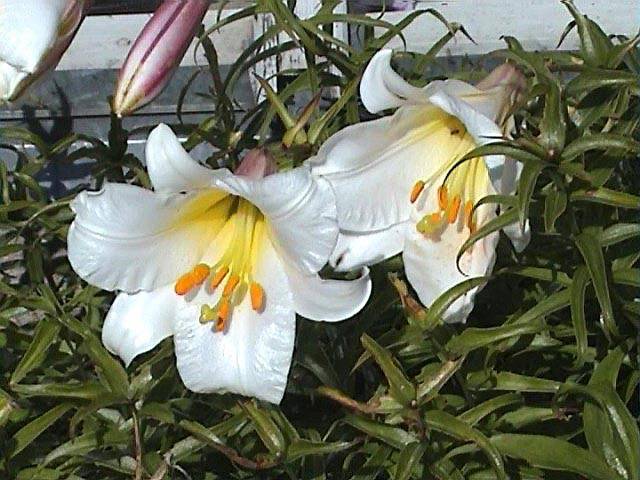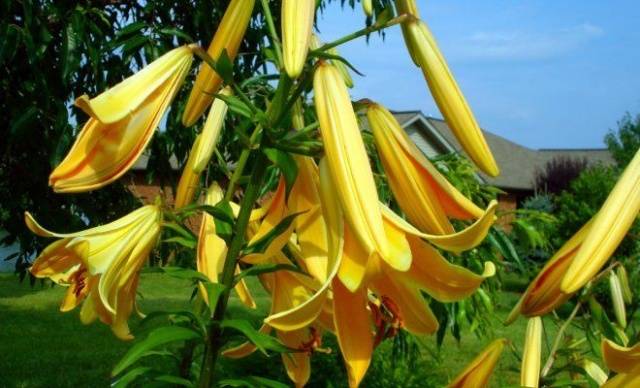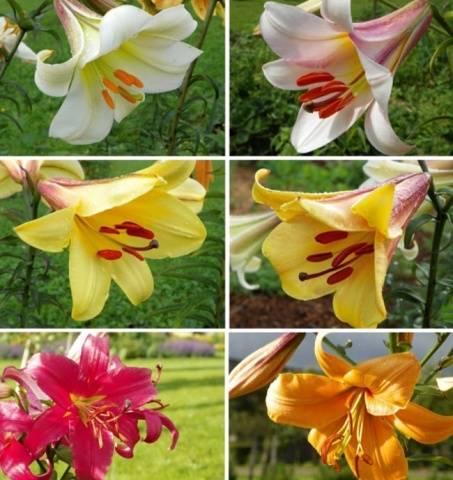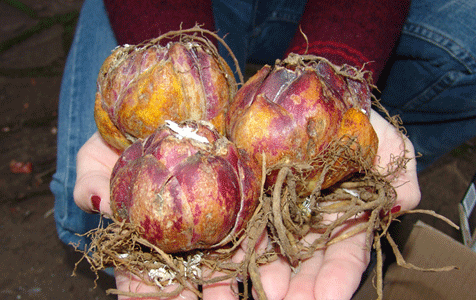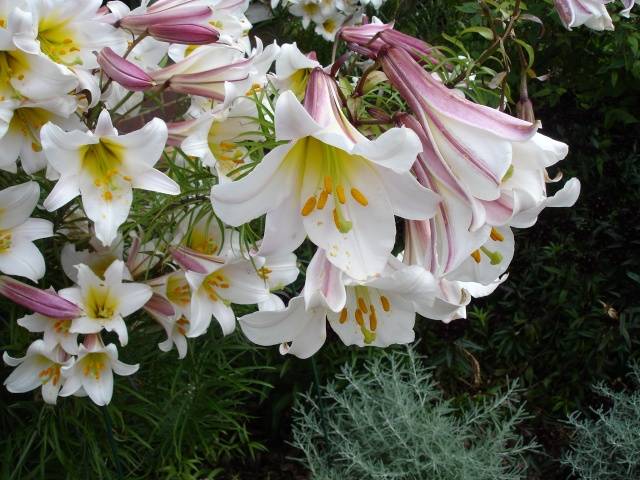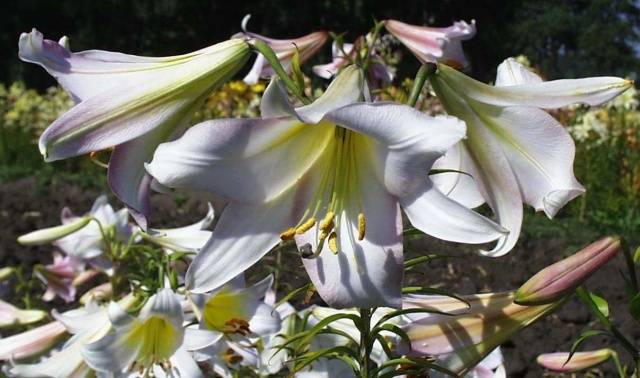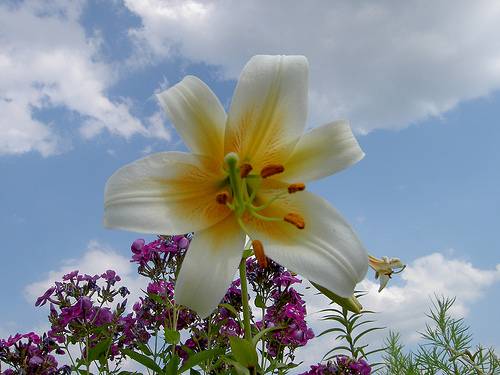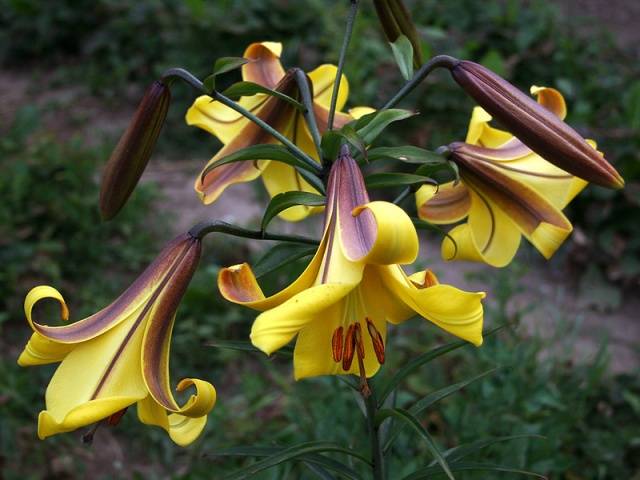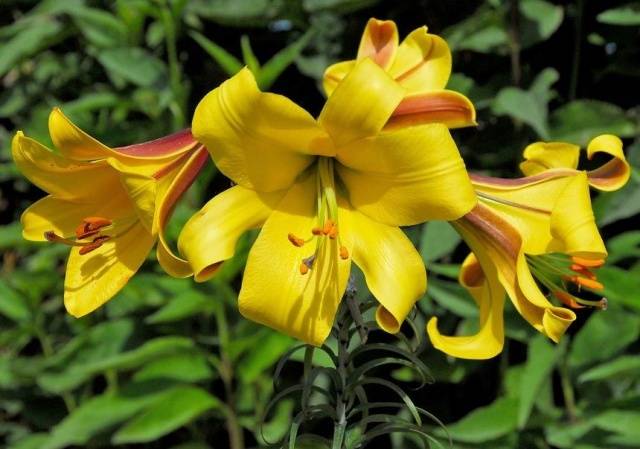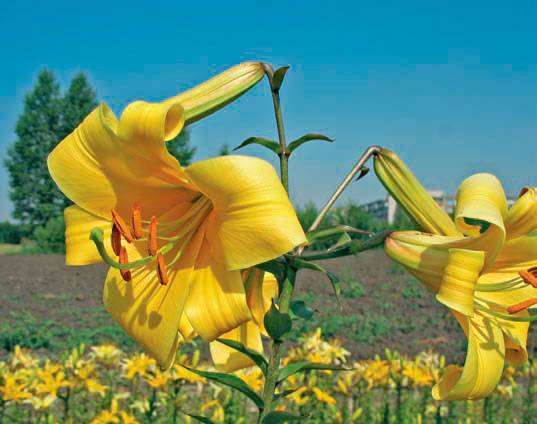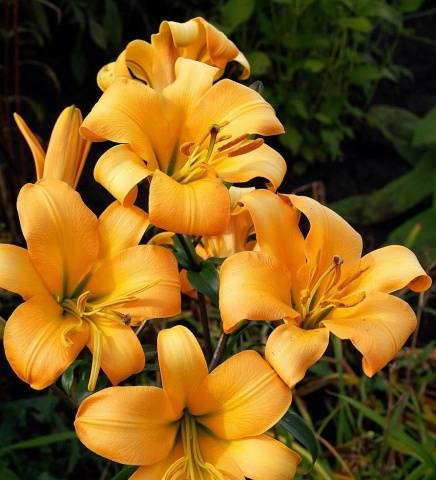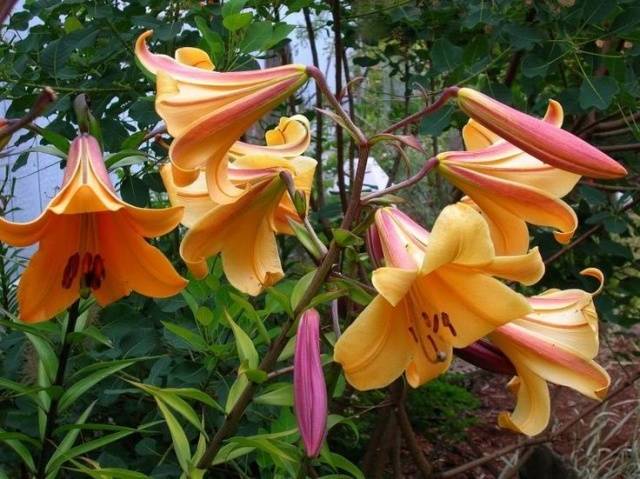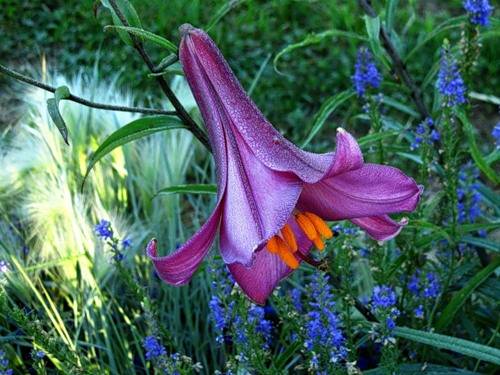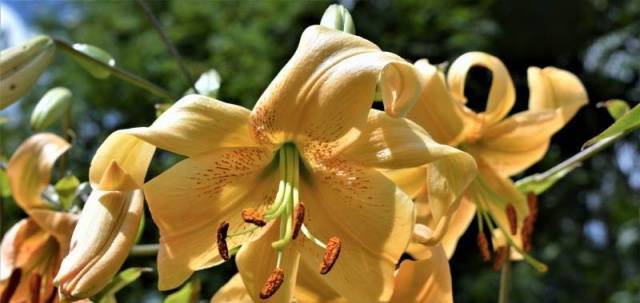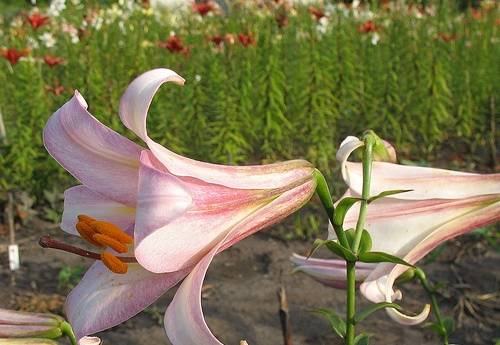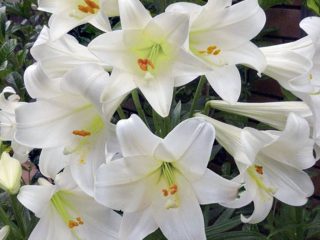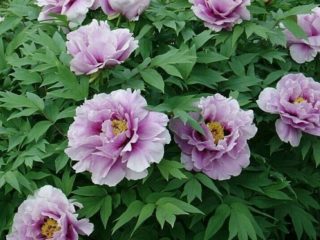Content
Almost any person, even far from floriculture and nature, who happens to be near the tubular lilies at the time of their flowering, will not be able to remain indifferent to this spectacle. Not only do huge flowers of various colors on giant stems sway spectacularly in the wind, their aroma can be felt from several tens of meters away, so that the interested gaze involuntarily stops for a couple of moments on these regal flowers full of beauty and grandeur. In the article you can find information not only about the varieties of tubular lilies with photos, but also about the features of their development and care for them.
History of creation and place in the classification
In natural conditions, there are about 100 different types of lilies, but only a few varieties have a tubular shape of flowers. The most luxurious representative of the natural species with tubular flowers is lily regal or royal (Lilium regale), found for the first time in China at the very beginning of the 20th century by the English botanist E. Wilson.
It was found in the mountains at an altitude of about 1600 meters above sea level among dry grasses and stunted bushes. Brought to Europe, the plant was distinguished by a strong aroma, white color and a classic tubular shape of flowers, as well as resistance to fungal and viral diseases.
In addition to the royal lily, the following natural types of lilies are characterized by the tubular shape of flowers:
- Sargent (L. Sargentiae);
- Sulfur yellow (L. Sulfureum);
- Glorious (L. Gloriosum);
- White-flowered (L. Leucanthum).
All of these natural varieties are predominantly from Asia and were used in subsequent breeding work. On their basis, many new hybrids were bred, which later received the general name tubular lily hybrids.
At one time, in the official international classification, they even belonged to the same group called tubular and Orleans hybrids.
A great contribution to the development of the selection of tubular lilies was made by Russian scientists, and above all those working at VNIIS im. Michurin. They have created about 100 varieties of tubular lilies, which are well adapted to the Russian climatic conditions of growth. Breeding work continues actively at the present time.
In the modern international classification of lilies, there are 10 divisions, and the sixth division is simply called tubular lily hybrids. On the packages of planting material, the belonging of the bulb to the tubular lily hybrids is indicated by the Latin number VI, which denotes the sixth section. More than 1000 colors are currently known in this section.
Description of plants
Tubular lilies, as a rule, are very large plants with a height of 120 to 250 cm, although among them there are also medium-sized varieties, about 70-80 cm in height.Initially, this group of lilies received their name for flowers, the base of which is elongated into a tube and only then drop-down like a gramophone. Although at the moment the section of tubular lilies is very diverse and it contains plants with flowers of the most diverse forms, including cupped, drooping and even star-shaped.
The stems are thin, but very strong, the leaves are elongated and narrow.
The color of the flowers is very diverse - there are various shades of colors, except for blue. The flower petals are very dense and they are not afraid of either rain or wind. The flowers of tubular lilies are also distinguished by their large size, reaching from 12 to 18 cm in length, and an intense aroma, which is especially noticeable at night. Non-double flowers have about 6 petals arranged in two rows, double varieties contain much more petals.
In the inflorescence, from 5 to 20 flowers can form, which open in turn. One flower lasts for about a week.
The aroma of flowers is so strong that it is strongly discouraged not only to bring bouquets of cut flowers into the house to decorate it, but also to plant plants in the immediate vicinity of the windows of the house, especially from the rooms where you usually rest. It can cause headaches in sensitive people.
The flowering of tubular lilies usually occurs in the second half of summer, thus, they can be attributed to the late-flowering varieties of lilies. Bulbs also grow to a large size, which is especially important to consider when choosing planting material. When buying tubular lily bulbs, pay attention to the following points:
- The bulbs must be large, in any case at least 3-4 cm in diameter, otherwise they risk becoming unviable.
- They should be firm and resilient, free from stains and signs of mold or decay.
- Excessive hardness and dryness of the bulbs is also undesirable, as they may be overdried.
- The packaging must not be wrinkled or damaged.
The color of the scales in the lily bulbs of this group in the air often acquires a purple-burgundy hue, which makes it possible to distinguish them from lilies of other varieties.
A distinctive feature of tubular lilies is a rather long flowering time, which is not typical of most lilies. Some varieties of this group can delight with their flowering for up to a month or even more.
Tubular lilies are generally more hardy than many other varieties of lilies, such as the long-flowered or oriental lily. In this respect, they rank second after Asian hybrids. Their resistance to fungal and viral diseases is especially important. They winter well in the climatic conditions of the middle zone under a snow cover, although in the first years after planting they should still be additionally covered with a small layer of spruce branches.
Features of planting and care
Originally from mountainous regions, pipe lilies are not particularly demanding on soil fertility. Much more important for them is a sunny place and loose, well-drained soil. In low-lying, damp places, they are unlikely to grow well, and may soon die.
This type of lily has the ability to tolerate recurrent frosts well. For this reason, bulbs can also be planted in spring. It is only necessary to take into account that in the first year the plants should not be allowed to bloom, otherwise they may weaken greatly and not survive the winter.
A feature of tubular lilies is a low coefficient of vegetative reproduction, which means that in one or two seasons, only one or two additional bulbs can be formed. Therefore, if you want to multiply them, it is better to use the method of reproduction by scales.
Varieties and their descriptions
Since the ancestor of all tubular lilies was the royal lily of a snow-white shade, then until now the white color occupies a special place in the color scheme of this group of lilies.
White lilies
The varieties of tubular white lilies are the most numerous and the following hybrids are the most popular among them.
Regale
The name of this hybrid completely coincides with the Latin name of the species natural royal lily. From her she took all her most outstanding characteristics: height reaching 180-200 cm, unpretentious care, and a wonderful smell. The flowers, made as if made of ivory, have a unique color - white, with a yellow frame on the inner central part, and on the outside they are covered with dark pink stains. The funnel-shaped flower reaches 20 cm in length.
Flowers appear around mid-summer. Up to 15 flowers can form in the inflorescence. If a place for this lily is chosen with partial shading during the day, then flowering can last up to a month or more.
Wedding waltz
This variety was bred at the V.I. Michurin. The plant reaches a height of only 80-90 cm. Short inflorescences form 3 to 5 flowers of a pronounced tubular shape. The flowers are snow-white with a yellow center and veins. The diameter of one flower can be 12 cm. Flowering occurs in the second half of July.
Aria
Also a creation of a group of breeders from the Michurinsky Institute of Horticulture, bred in 2010. The plants reach 110-120 cm in height. In the inflorescence, from 4 to 11 wide cupped flowers can form, which can be directed both downward and to the sides. The flower itself is white, the inner pharynx is yellow, and the inner petals at the base are decorated with burgundy strokes. Outside, the buds have a barely noticeable greenish tint. It is interesting that the anthers are semi-sterile and do not get dirty at all, so the flowers do not cause any inconvenience in cut bouquets.
White America
A snow-white lily with a slightly yellowish inner part of the neck is an achievement of foreign breeders. Blooms in July and August. The height of plants usually does not exceed 100 cm. But the flowers are large in size, up to 17 cm in diameter.
Loves both sunny and slightly shaded places. The bulbs are planted to a depth of 15-20 cm.
Yellow and orange lilies
Tubular lilies of yellowish shades look very elegant and cheerful. Among the varieties of this shade, the following are the most popular.
Golden Splendor
The very name of this variety in translation from English - golden luxury - says a lot. Plants are tall, reaching 120 cm, flowers are also large in size, up to 15-17 cm in diameter. The bright yellow flowers are bordered on the outside by dark pink irregular stripes. The aroma of the flowers is extremely intense, sweet and spicy. They bloom actively from July to August.
Lilies are resistant to frost and repeated frost and to most diseases.
Royal Gold
Another variety from Holland, characterized by a uniform golden-yellow color of the petals with a barely noticeable brownish bloom at the base of the outer side of the buds. They do not differ in gigantic dimensions in height, but the flowers can reach 20 cm in diameter. The stamens are dark yellow and the pistil is brown-blue.
The aroma, like many other representatives of tubular lilies, is strong, with spicy notes. Flowering is long, can last from late July to late summer.
Sunny morning
This variety was created by Russian breeders at the Michurinsky Institute of Horticulture in 2013. Plants are medium in height, not exceeding a meter. The green flowering shoot is decorated with purple strokes. The color of the flowers is light yellow, up to seven flowers with a diameter of up to 12 cm open in the inflorescence. The variety is distinguished by an almost complete absence of aroma.
Flowering begins in early July and lasts an average of about a month.
Sultry summer
The Russian variety is registered at the International Lily Registration Center in London. The flower has a yellowish orange color with a darker center. Reaches 120 cm in height. It also blooms in early July.
Orange Planet
The creation of Dutch breeders allows you to have on the plant in the first year after planting from 3 to 5 flowers.In the future, the lily will grow, and the number of flowers can reach 10-12. These giants can reach 160-180 cm in height. Flowers up to 18 cm in diameter have a delicate apricot shade and a delicate, unobtrusive aroma.
African Queen
Judging by the reviews of gardeners, this variety is one of the most popular among pipe lilies and it is not in vain that it claims to be a king. The lily African Queen can reach a height of two meters, and the fragrant, porcelain-like flowers can be up to 20 cm in diameter. The rich orange color with dark strokes on the outside of the buds makes the flowers extremely bright and attractive.
It blooms in July-August. Plants of this variety tolerate return frosts well and are able to develop even on slightly acidic soil.
Lilies of other color shades
Among the tube lilies of a wide variety of colors, the following varieties are most popular.
Pink Perfection
This variety is perhaps the most popular of all pipe lilies in recent years. It is distinguished by truly gigantic sizes of both the plant itself (up to 200-220 cm) and flowers (up to 25 cm). The flowers have a unique dark pink and sometimes purple color with bright yellow stamens.
Blooms like most pipe lilies from July to August. Differs in resistance to bad weather and diseases.
Octave
The authors of this delicate lily are Russian breeders Pugacheva and Sokolova. The variety was registered at the international center in London in 2013. The inflorescence is rather loose, contains up to 12 flowers of a wide-cupped shape with bent petals. The flowers are colored in a delicate mixture of yellow and pink tones and have a mild pleasant aroma. Flowering lasts about a month from the second half of July. Plants are tall (up to 150 cm) with a flower diameter of up to 15 cm.
The variety is resistant to disease and drought, and tolerates winter well.
Flamingo
This variety was patented by the Institute of Horticulture named after Michurin in 2010. Its authors are G.M. Pugacheva. and Kireeva M.F.
The plants are medium in height (80-90 cm), but the flowers have a unique color. Outside, they are pinkish, speckled with dark strokes, inside they are pink-white with a darker edge and a yellow-green center. Blooms in July.
Conclusion
The spectacular appearance and dimensions, the duration of flowering and the enchanting aroma of tubular lilies cannot fail to attract the attention of gardeners to them. In addition, these flowers are distinguished by their sufficient unpretentiousness in care and relative winter hardiness, if you create suitable conditions for growth for them from the very beginning.
